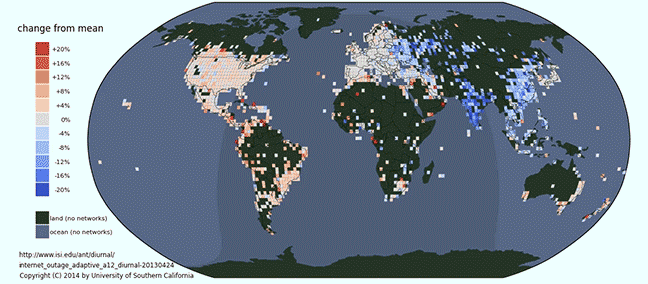The internet is a little bit like an organism—a really huge organism, made up of over four billion IP addresses networked across the globe. How does the internet behave day to day? What are its natural cycles?
USC Viterbi School of Engineering project leader and computer science assistant professor, John Heidemann, decided to find out.
In collaboration with Lin Quan and Yuri Pradkin, Heidemann pinged 3.7 million IP address blocks—representing almost a billion unique IP addresses—every 11 minutes for two months earlier this year. They asked the simple question: When are these addresses active and when are they sleeping?
The team found some interesting trends. IP addresses using home WiFi routers in countries like the US and Western Europe were consistently on (or awake) around the clock, whereas addresses in Eastern Europe, South America, and Asia tended to cycle more regularly with day and night.
Why is this important? Think of it as a method for differentiating between a “sleeping” internet and a “broken” internet.
“This data helps us establish a baseline for the internet,” says Heidemann, “To understand how it functions, so that we have a better idea of how resilient it is as a whole, and can spot problems quicker.”
The simplest use of the data may be akin to a health checkup, but there might be other interesting research outcomes too. For example, an “always on” internet may correlate with economic development. Over the years, we might be able to track how countries are doing, adding internet data to other broad statistics like GDP.
You might also have noticed there are big holes in the map in Africa, Asia, and South America. These in part correlate to low-population areas—but they also show where internet coverage is still spotty. Indeed, billions around the world still lack regular internet access (a situation Google and Facebook are intent on remedying).
Heidemann’s map is intriguing, in part, because it’s a striking visual representation of just how connected the planet already is—and just how much more connected it is likely to become over next few years and decades.
Image Credit: USC Viterbi School of Engineering




